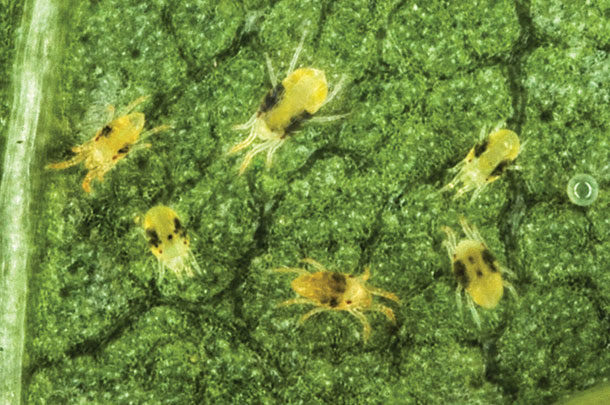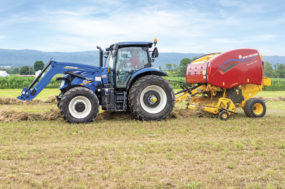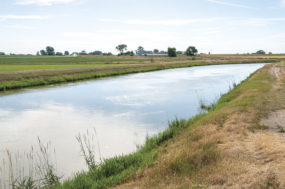That’s no surprise. These tiny pests can be easy to miss. And in hot, dry weather, they reproduce rapidly. A new generation of mites can develop in just four to seven days. Sixty female mites can produce as many as 26 million additional adults in 15 days.
Be proactive
To prevent spider mite infestations, it’s important to manage dust on end rows, roads and ditches. Infestations commonly begin in field edges near dirt or gravel roads. Spider mites spread among fields by climbing to the top of a plant and spinning tiny strands of silk.
When dust is caught by the wind, mites travel on the dust and drift to new host plants. Female spider mites then lay their eggs on the underside of plant leaves. It’s a good practice for growers to wet field roads regularly to minimize dust and keep ditches and field edges clear of weeds, which can catch dust and serve as mite hosts.
Beat the heat
Monitor topsoil moisture and schedule timely irrigations to create a humid, moist environment that spider mites don’t like. Successful corn silage growers never let their soil dry out.
Take action early
Once detected, mites have already begun inflicting damage. If you look at the underside of a leaf and see fine, white webbing, the field is infested with a significant population of spider mites. That’s why it’s important to lock in your insecticide program and spraying schedule before planting.
Develop an effective miticide protocol
The best time to spray a miticide is when corn plants are approximately 48 to 64 inches tall. Complete plant coverage is critical. Ground sprayers with drop nozzles are most effective because the spray reaches under the leaves. To get the best coverage, use maximum labeled rates for total spray volume.
If corn becomes too tall for a ground rig to get through, aerial application is an option, but it could be less effective because the spray may not penetrate the dense canopy. For aerial application, volume should also increase to the maximum labeled rate.
Miticides usually are most effective when they’re applied to your corn at the very first sight of mites. Not all miticides control adult spider mites; some target egg or immature pest stages. Others control all stages.
Always read and follow label directions to ensure you are using crop protection products in the right amount, under the right environmental conditions and at the right stage of crop growth.
Work with Mother Nature
Follow integrated pest management (IPM) guidelines and avoid insecticides that cause mites to flare or that kill beneficial insects. In addition, alternate modes of action each year, using at least two chemical classes to provide longer protection and discourage resistance. Two miticide applications will bolster mite suppression.
Spider mites are especially troublesome in the hot, dry climates of California and other Western states, where research shows spider mite infestations reduce corn silage yield by 4 to 6 tons per acre. Keeping mites under control is important, especially to ensure your corn silage meets dairy herd tonnage and nutritional requirements. You can avoid slipping into panic mode by following these tips to manage spider mites:
Learn to recognize them
Spider mites come in many types, but the most common are the two-spotted spider mite and Banks grass mite. Spider mites have four stages of development:
- The spherical, somewhat translucent egg stage
- The six-legged translucent larval stage
- The eight-legged nymphal stage
- The eight-legged adult stage
Adults measure about 0.06 inch in length, making them easy to miss when scouting fields. They have eight legs and are greenish to pink or cream-colored with black spots of various sizes on their bodies. Mites are not insects, although they’re related to them.
They are actually members of the arachnid class along with spiders and ticks. The names “spider mite” and “web-spinning mite” come from the silk webbing most species produce on infested leaves. The presence of webbing is an easy way to distinguish them from all other types of mites and small insects such as aphids and thrips, which can also infest leaf undersides.
Know where to look for them
Spider mites live in colonies on the underside of corn leaves. Infestations usually begin on the lower portions of the plants and move up as mite numbers increase. Heavy rain or overhead irrigation can wash off mites from foliage.
But with widespread furrow irrigation practices in the West, mites often remain shielded during the growing season. Not only do spider mites reside in silage corn, but they can also be found in cotton, trees such as almonds and pistachios, and many fruit and vegetable crops.
Work with your agronomist to limit damage
Mites use their needlelike stylets to puncture leaves and consume plant nutrients. By removing photosynthates from leaves, the mites cause premature death, loss of leaf tissue, stalk breakage and kernel shrink.
Damaged leaves become somewhat yellowish and stippled on the upper surface. They become grayish on the undersurface due to webbing. In addition to causing yield and tonnage losses, spider mite damage can lead to poor-quality silage with a low relative feed value. Work with your trusted agronomic adviser to understand yield-limiting pressures common in your area and determine how to minimize impact on crop yield. ![]()
Dennis Craig is a commercial agronomist with Mycogen Seeds. Email Dennis Craig.
PHOTO: Spider mites. Photo courtesy of Dennis Craig, via David Cappaert (bugwood.org).
Tips for spider mite management
Do...
- Use a ground sprayer with drop nozzles that sprays miticides up under the leaves. Aerial applications can be used once the corn is too tall to get through with a ground rig, but they aren’t as effective because the spray won’t penetrate the thick canopy.
- Use maximum labeled rates for total spray volume to get the best coverage. Complete coverage is critical.
- Use miticides with different modes of action to treat these pests. What worked great last year may not be as effective this year because spider mites build resistance to miticides.
- Visit the University of California’s IPM website for more information: UC Davis - Pest Management Guidelines and UC Davis - Pests in Gardens and Landscapes
- Work with your local agronomist to understand yield-limiting pressures in your area.
Don’t...
- Let dust overtake end rows, roads and ditches or let weeds in ditches grow out of control. These environments are great hosts for mites.
- Wait until you see mites in your field to start treatment. By then, they’re already doing damage. Treat early.
- Be lulled into thinking the additional rainfall El Niño has brought will somehow lessen the threat of spider mites. Count yourself lucky if you have additional water supplies and schedule timely irrigations. Don’t let your soil go dry.
- Gamble on spider mite treatment. Remember that not using a miticide could result in a 4- to 6-ton loss in your corn silage yield.









